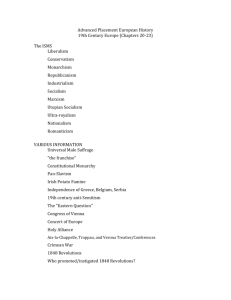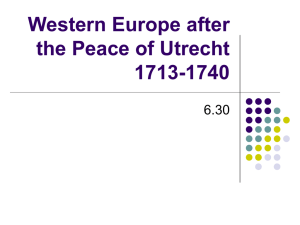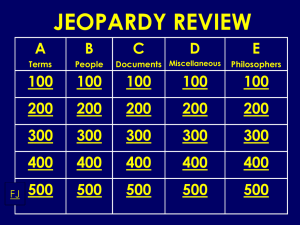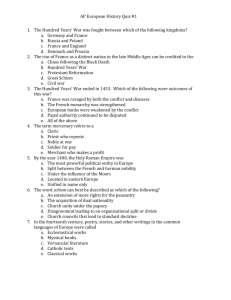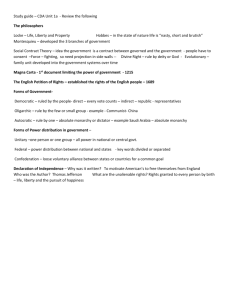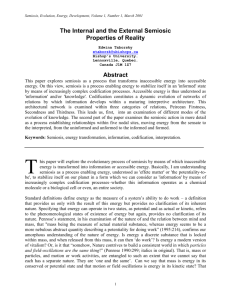this outline.
advertisement
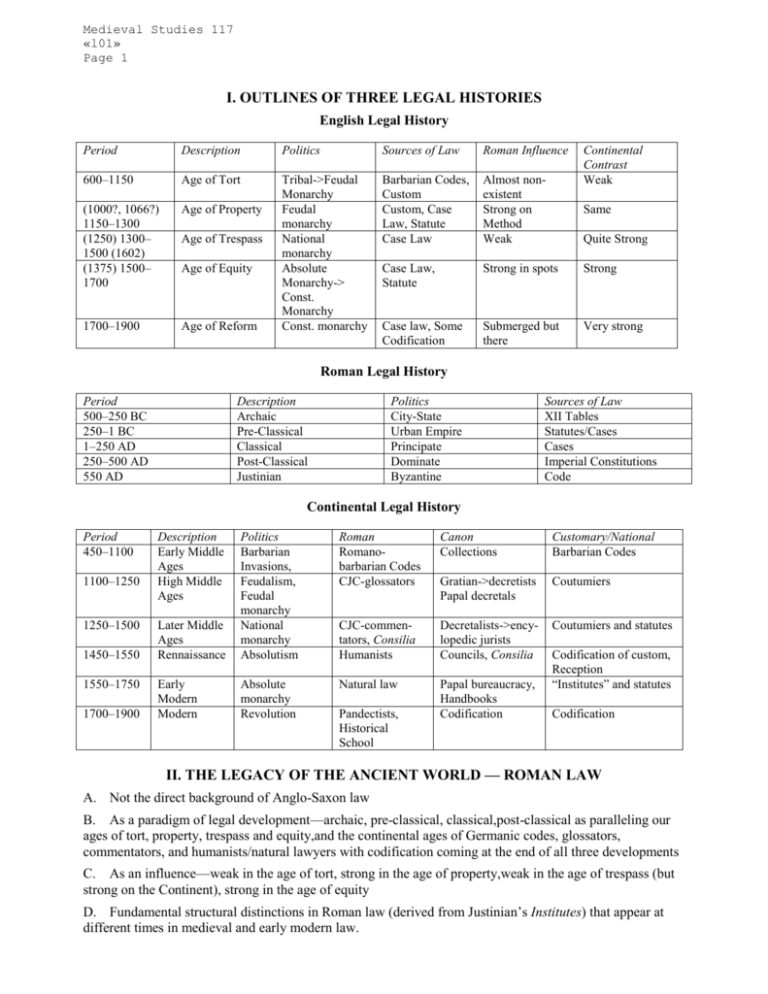
Medieval Studies 117 «l01» Page 1 I. OUTLINES OF THREE LEGAL HISTORIES English Legal History Period Description Politics Sources of Law Roman Influence 600–1150 Age of Tort (1000?, 1066?) 1150–1300 (1250) 1300– 1500 (1602) (1375) 1500– 1700 Age of Property Barbarian Codes, Custom Custom, Case Law, Statute Case Law Almost nonexistent Strong on Method Weak Case Law, Statute Strong in spots Strong 1700–1900 Age of Reform Tribal->Feudal Monarchy Feudal monarchy National monarchy Absolute Monarchy-> Const. Monarchy Const. monarchy Case law, Some Codification Submerged but there Very strong Age of Trespass Age of Equity Continental Contrast Weak Same Quite Strong Roman Legal History Period 500–250 BC 250–1 BC 1–250 AD 250–500 AD 550 AD Description Archaic Pre-Classical Classical Post-Classical Justinian Politics City-State Urban Empire Principate Dominate Byzantine Sources of Law XII Tables Statutes/Cases Cases Imperial Constitutions Code Continental Legal History Period 450–1100 1100–1250 1250–1500 1450–1550 1550–1750 1700–1900 Description Early Middle Ages High Middle Ages Roman Romanobarbarian Codes CJC-glossators Canon Collections Customary/National Barbarian Codes Gratian->decretists Papal decretals Coutumiers Later Middle Ages Rennaissance Politics Barbarian Invasions, Feudalism, Feudal monarchy National monarchy Absolutism CJC-commentators, Consilia Humanists Decretalists->encylopedic jurists Councils, Consilia Coutumiers and statutes Early Modern Modern Absolute monarchy Revolution Natural law Papal bureaucracy, Handbooks Codification Pandectists, Historical School Codification of custom, Reception “Institutes” and statutes Codification II. THE LEGACY OF THE ANCIENT WORLD — ROMAN LAW A. Not the direct background of Anglo-Saxon law B. As a paradigm of legal development—archaic, pre-classical, classical,post-classical as paralleling our ages of tort, property, trespass and equity,and the continental ages of Germanic codes, glossators, commentators, and humanists/natural lawyers with codification coming at the end of all three developments C. As an influence—weak in the age of tort, strong in the age of property,weak in the age of trespass (but strong on the Continent), strong in the age of equity D. Fundamental structural distinctions in Roman law (derived from Justinian’s Institutes) that appear at different times in medieval and early modern law. Medieval Studies 117 «l01» Page 2 Justinian’s Institutes (Basic Categories) J.I.1.1.3–4. The study of the law consists of two branches, law public, and law private. The former relates to the welfare of the Roman State; the latter to the advantage of the individual citizen. Of private law then we may say that it is of threefold origin, being collected from the precepts of nature, from those of the law of nations, or from those of the civil law of Rome. J.I.1.2.12. The whole of the law which we observe relates either to persons, or to things, or to actions. And first let us speak of persons: for it is useless to know the law without knowing the persons for whose sake it was established. J.I.2.1pr. In the preceding book we have expounded the law of Persons: now let us proceed to the law of Things. Of these some admit of private ownership, while others, it is held, cannot belong to individuals: for some things are by natural law common to all, some are public, some belong to a society or corporation, and some belong to no one. But most things belong to individuals, being acquired by various titles, as will appear from what follows. J.I.2.6pr. It was a rule of the civil law that if a man in good faith bought a thing, or received it by way of gift, or on any other lawful ground, from a person who was not its owner, but whom he believed to be such, he should acquire it by usucapion—if a movable, by one year’s possession, and by two years’ possession if an immovable, though in this case only if it were in Italian soil;—the reason of the rule being the inexpediency of allowing ownership to be long unascertained. The ancients thus considered that the periods mentioned were sufficient to enable owners to look after their property; but we have arrived at a better opinion, in order to save people from being over-quickly defrauded of their own, and to prevent the benefit of this institution from being confined to only a certain part of the empire. We have consequently published a constitution on the subject, enacting that the period of usucapion for movables shall be three years, and that ownership of immovables shall be acquired by long possession—possession, that is to say, for ten years, if both parties dwell in the same province, and for twenty years if in different provinces; and things may in these modes be acquired in full ownership, provided the possession commences on a lawful ground, not only in Italy but in every land subject to our sway. J.I.2.9.6. So much at present concerning the modes of acquiring rights over single things: for direct and fiduciary bequests, which are also among such modes, will find a more suitable place in a later portion of our treatise. We proceed therefore to the titles whereby an aggregate of rights is acquired. If you become the successors, civil or praetorian, of a person deceased, or adopt an independent person by adrogation, or become assignees of a deceased’s estate in order to secure their liberty to slaves manumitted by his will, the whole estate of those persons is transferred to you in an aggregate mass. J.I.3.1.13. Let us now pass on to obligations. An obligation is a legal bond, with which we are bound by a necessity of performing some act according to the laws of our State. … [T]hey are arranged in four classes, contractual, quasi-contractual, delictal, and quasi-delictal. And, first, we must examine those which are contractual, and which again fall into four species, for contract is concluded either by delivery, by a form of words, by writing, or by consent: each of which we will treat in detail. J.I.4.1pr. Having treated in the preceding Book of contractual and quasi-contractual obligations, it remains to inquire into obligations arising from delict. The former, as we remarked in the proper place, are divided into four kinds; but of these latter there is but one kind, for, like obligations arising from real contracts, they all originate in some act, that is to say, in the delict itself, such as a theft, a robbery, wrongful damage, or injury. J.I. 4.6pr. The subject of actions still remains for discussion. An action is nothing else than the right of suing before a judge for what is due to one.
